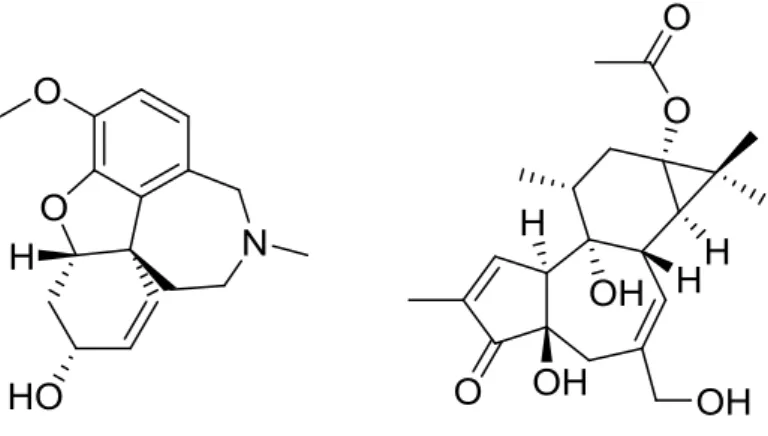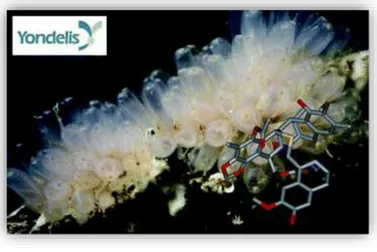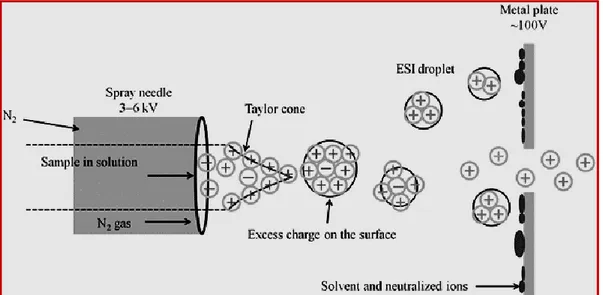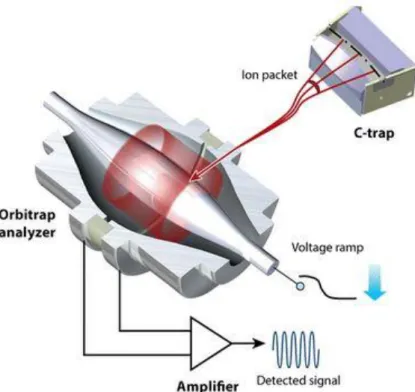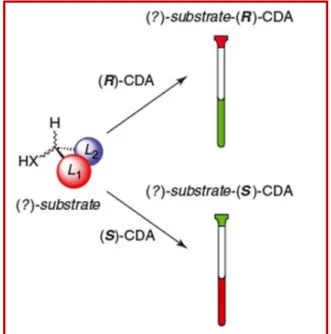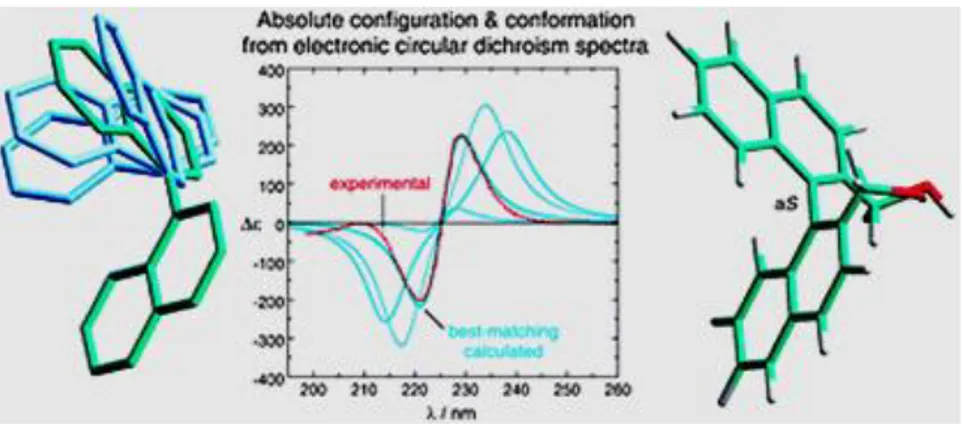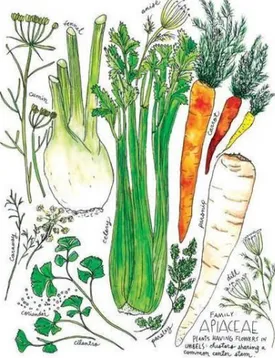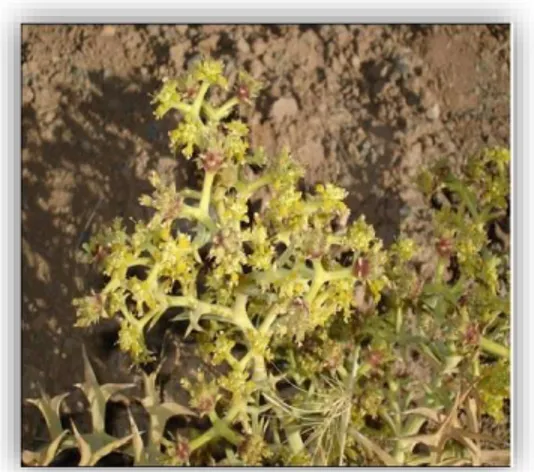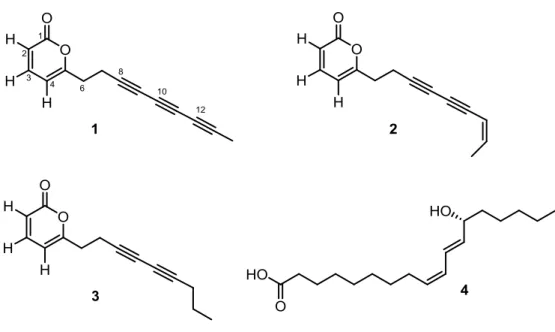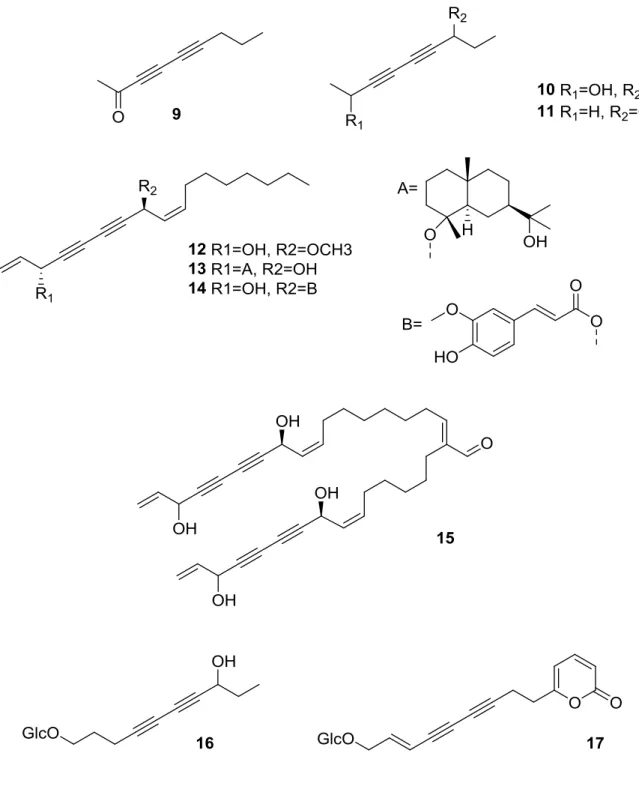DEPARTMENT OF PHARMACY
Ph.D. THESIS
IN
“PHARMACEUTICAL SCIENCE”
Phytochemical and synthetic studies on bioactive secondary
metabolites from Apiaceae plants growing in Mediterranean and
Middle-East regions
Supervisor:
Coordinator:
Prof. Daniela Rigano
Prof. Maria Valeria D’Auria
Candidate:
Dr. Carmina Sirignano
XXXI cycle
Look up at the stars and not down at your feet. Try to make sense of what you see, and wonder about what makes the universe exist. Be curious. (Stephen Hawking)
Table of contents
Abstract ... i
Publications of the candidate during the PhD period ... ii
CHAPTER 1 ... 1
NATURAL PRODUCTS: A NEVER-ENDING INSPIRATION FOR DRUG DISCOVERY ... 1
1.1 Plants as a source of natural products ... 2
1.2 The role of synthetic chemistry in the natural products field ... 3
References ... 7
CHAPTER 2 ... TECHNIQUES AND METHODS EMPLOYED IN THIS STUDY ... 9
2.1 Isolation procedures ... 9
2.2 Mass spectrometry ... 10
2.3 Nuclear Magnetic Resonance ... 12
2.4 Determination of stereochemistry ... 14
2.4.1 Determination of relative configuration ... 14
2.4.1.1 Murata’s Method ... 15
2.4.2 Determination of absolute configuration ... 17
2.4.2.1 Marfey’s Method ... 17
2.4.2.2 Mosher’s Method ... 17
2.4.2.3 Electronic circular dichroism ... 19
2.5 General Experimental Section for this PhD thesis ... 20
References ... 21
CHAPTER 3: ... TRPA1 MODULATING C14 POLYACETYLENES FROM THE IRANIAN ENDEMIC PLANT ECHINOPHORA PLATYLOBA ... 23
3.1 The Apiaceae family ... 23
3.1.1 Echinophora genus ... 25
3.2 Polyacetylenes from Apiaceae family and their biosynthesis ... 28
3.3 Polycetylenes from Echinophora platyloba ... 31
3.4 Activity on transient receptor potential ion channels ... 33
3.5 Experimental section ... 37
3.5.1 Plant material, extraction and isolation ... 37
3.5.2 Spectroscopic data for the isolated compound ... 38
References ... 40
CHAPTER 4: ... PLASMODIUM TRANSMISSION BLOCKING AND ANTIPROLIFERATIVE METABOLITES FROM DAUCUS VIRGATUS, A TUNISIAN ENDEMIC PLANT ... 44
4.1 Daucus genus ... 45
4.2 Malaria: a still alarming global burden ... 47
4.2.1 Plants traditionally used to treat malaria ... 50
4.3 The biosynthesis of Daucus sesquiterpenes ... 52
4.4 Isolation and structural elucidation of angeloylated germacranolides with Plasmodium transmission-blocking activity ... 58
4.5 Absolute configuration of daucovirgolides ... 64
4.6 Plasmodium transmission-blocking activity ... 68
4.7 Antiproliferative metabolites from Daucus virgatus apolar extract ... 72
4.7.1 Structural elucidation of the isolated metabolites ... 72
4.8 Antiproliferative activity ... 77
4.9 Experimental section ... 79
4.9.1 Plant material, extraction and isolation ... 79
4.9.2 Spectroscopic data for the isolated compounds ... 81
4.9.3 Evaluation of Transmission Blocking Activity ... 84
4.9.4 Antiproliferative activity ... 86
4.9.5 Computational Calculations ... 86
References ... 88
CHAPTER 5: ... STUDIES TOWARDS THE TOTAL SYNTHESIS OF DAUCOVIRGOLIDE G ... 93
5.1 Total synthesis of germacrane sesquiterpenes ... 93
5.1.1 The first total synthesis of a germacranolide: (+)-dihydrocostunolide... 93
5.1.2 The total synthesis of (+)-costunolide... 95
5.1.3 Total synthesis of (±)-acoragermacrone ... 98
5.1.4 Baran’s approach to the formation of the germacranolides’ ten-membered carbocycle ... 99
5.2 Retrosynthetic analysis of daucovirgolide G ... 100
5.3 Synthesis of daucovirgolide G ... 101
5.3.1 Preparation of (2E,6E)-8-hydroxy-3,7-dimethylocta-2,6-dien-1-yl acetate ... 101
5.3.2 Preparation of (2E,6E)-8-((tert-butyldimethylsilyl)
oxy)-3,7-dimethylocta-2,6-dien-1-ol (53) ... 102
5.3.3 Preparation of (2E,6E)-8-((tert-butyldimethylsilyl)oxy)-3,7-dimethylocta-2,6-dienal (50) ... 103
5.3.4 Preparation of ethyl (2S,3R,4E,8E)-3,10-dihydroxy-5,9-dimethyl-2-(prop 1-en-2-yl)deca-4,8-dienoate (anti-55a) ... 104
5.3.5 Attempted synthesis of (2R,3R,4E,8E)-3,10-bis((tert-butyldimethylsilyl)oxy)-5,9-dimethyl-2-(prop-1-en-2-yl)deca-4,8-dien-1-ol (60). ... 106
5.3.6 Preparation of (2R,3R,4E,8E)-3,10-bis((tert-butyldimethylsilyl)oxy)-5,9-dimethyl-2-(prop-1-en-2-yl)deca-4,8-dien-1-ol from anti-β-Hydroxy-ester and attempted oxidation to aldehyde. ... 107
5.4 Experimental section ... 108 References ... 112 CHAPTER 6 ... CONCLUSIONS ... 114 CHAPTER 7 ... SPECTRAL DATA ... 116
Spectral data for CHAPTER 3 ... 116
Spectral data for CHAPTER 4 ... 118
i
Abstract
Natural products represent a remarkable source of lead molecules for drug discovery, given their impressive structural diversity and their still unexplored potential. Considering that more than 90% of the world’s biodiversity still waits to be investigated, Nature continues to be a gold mine of new chemotypes and pharmacophores. Thus, taking into account all the potential sources, including plants, fungi, bacteria, and marine environment, approximately one-third of all New Molecular Entities (NMEs) approved by Food and Drug Administration (FDA) derives from natural products. In this context, the research work reported in this Ph.D. thesis has been focused on the phytochemical investigation of plants belonging to the Iranian and Northern African flora, in order to discover and rationalize their pharmacological potential. In particular, the first part of my work has been devoted to the characterization of the polyacetylene fraction of Echinophora platyloba, which pointed out a new interesting TRPA1 modulating activity of C14 polyacetylenes isolated from this Iranian endemic plant.
Subsequently, the bio-guided fractionation of the apolar extract obtained from Daucus virgatus, a Tunisian endemic plant, led to the isolation of angeloylated germacranolides showing a promising Plasmodium transmission blocking activity. Moreover, the complete phytochemical characterization of D. virgatus apolar extract has resulted in the isolation of additional antiproliferative secondary metabolites. Part of my Ph.D. project has been spent at University College of Dublin (UCD), to design and initiate a synthetic strategy for the preparation of daucovirgolide G, the angeloylated germacranolide that showed the most promising anti-malarial activity, among all those isolated from D. virgatus. The total synthesis of daucovirgolide G, which is still in progress, will have as final goal the preparation of the active compound and of several analogues to be pharmacologically evaluated.
The results obtained during my Ph.D. have been reported in nine papers already published or ready for publication.
ii
Publications of the candidate during the Ph.D. period
1. Chianese, G., Yu, H. B., Yang, F., Sirignano, C., Luciano, P., Han, B. N., & Taglialatela-Scafati, O. (2016). PPAR modulating polyketides from a Chinese Plakortis simplex and clues on the origin of their chemodiversity. The Journal of organic chemistry, 81(12), 5135-5143.
2. Formisano, C., Sanna, C., Ballero, M., Chianese, G., Sirignano, C., Rigano, D., & Taglialatela-Scafati, O. (2017). Anti-inflammatory sesquiterpene lactones from Onopordum illyricum L. (Asteraceae), an Italian medicinal plant. Fitoterapia, 116, 61-65.
3. Formisano, C., Sirignano, C., Rigano, D., Chianese, G., Zengin, G., Seo, E. J., & Taglialatela-Scafati, O. (2017). Antiproliferative activity against leukemia cells of sesquiterpene lactones from the Turkish endemic plant Centaurea drabifolia subsp. detonsa. Fitoterapia, 120, 98-102.
4. Del Prete, D., Taglialatela-Scafati, O., Minassi, A., Sirignano, C., Cruz, C., Bellido, M. L., & Appendino, G. (2017). Electrophilic triterpenoid enones: a comparative thiol-trapping and bioactivity study. Journal of natural products, 80(8), 2276-2283.
5. Rigano, D., Sirignano, C., & Taglialatela-Scafati, O. (2017). The potential of natural products for targeting PPARα. Acta Pharmaceutica Sinica B, 7(4), 427-438.
6. Snene, A., # Sirignano, C., # Rigano, D., Formisano, C., El Mokni, R., Ercolano, G., & Taglialatela-Scafati, O. (2017). Antiproliferative metabolites from the Northern African endemic plant Daucus virgatus (Apiaceae). Phytochemistry, 143, 194-198.
7. Sirignano, C., # Snene, A., # Rigano, D., Tapanelli, S., Formisano, C., Luciano, P., & Taglialatela-Scafati, O. (2017). Angeloylated Germacranolides from Daucus virgatus and Their Plasmodium
iii Transmission Blocking Activity. Journal of natural products, 80(10), 2787-2794.
8. Chianese, G., # Sirignano, C., # Shokoohinia, Y., Mohammadi, Z., Bazvandi, L., Jafari, F., & Rigano, D. (2018). TRPA1 Modulating C14 Polyacetylenes from the Iranian Endemic Plant Echinophora platyloba. Molecules, 23(7), 1750.
9. Formisano, C., Rigano, D., Lopatriello, A., Sirignano, C., Arnoldi, L., Sardone, N., & Taglialatela-Scafati, O. Detailed phytochemical characterization of Bergamot by UPLC-DAD-MS and LC-NMR Analyses. Submitted
# These Authors contributed equally
1
CHAPTER 1
NATURAL PRODUCTS: A NEVER-ENDING INSPIRATION
FOR DRUG DISCOVERY
Natural products can be defined as secondary metabolites produced by natural sources, with the aim of ensuring an evolutionary advantage to the organisms that produce them. Indeed, unlike the primary metabolites (nucleic acids, proteins, fats, and carbohydrates), natural products are not necessary for survival, but they play an important role in defending terrestrial and marine organisms from predators or external threats, and in the interaction between species. Biological processes involved in the formation of secondary metabolites are essentially three: glycolysis, Krebs cycle, and photosynthesis; these metabolic reactions are responsible for the synthesis of intermediates, such as shikimic acid, acetyl coenzyme A (acetyl-CoA), mevalonic acid and 1-deoxyxylulose-5-phosphate, which provide a potentially unlimited number of natural products. In fact, due to different reasons, like environmental changes, chemicals, viruses etc., it can be seen that the secondary metabolism varies depending on the specific organism or species. Hence the extraordinary structural variability associated to natural compounds.1
Historically, many diseases have been treated utilizing natural remedies; over centuries, natural products have retained their relevance in the drug discovery process, even overcoming the slight downturn determined by the development of combinatorial chemistry and high-throughput screening (HTS). Thus, if we do not simply consider the number of natural products which effectively become final drugs, but also the number of new chemical entities (NCEs) inspired by the “Nature’s treasure trove of small molecules”, it seems to be clear that this field of research continues to be of remarkableimpact.Suffice to say that in a 30-year period, of 175 small molecules approved as new drugs with anticancer activity by FDA, or similar organizations, almost 50% is composed of natural products or compounds arising from their scaffolds.2 Besides, a huge sense of optimism has been brought to the worldwide research in the natural products field, by the award in 2015 of the Nobel Prize in Physiology or Medicine to William C. Campbell and Satoshi Omura, for the discovery of the microbial natural products avermectins,3 active against
2
onchocerciasis and lymphatic filariasis, and to Youyou Tu, for the discovery of artemisinin, an antimalarial natural product isolated from Artemisia annua L.4 This milestone provides a remarkable illustration of the value reached by the natural products-based drug discovery and opens the way to new challenging achievements in this field.5
1.1 Plants as a source of natural products
Since the dawn of time, mankind has been assisted by Nature to gain useful remedies to treat all kinds of illness. There is a huge wealth of knowledge on the use of medicinal plants that is possible to find in the traditional medicine from all over the world. Taking advantage of the known information handed down over time about the healing properties of some plant species, a specific line of research has led to the isolation of several new natural products with a broad variety of pharmacological properties. The study of medicinal plants used in traditional medicine, focusing on the active metabolites responsible for the pharmacological effect, is termed ethnopharmacology, and this kind of scientific approach has resulted in the discovery of many well-known pharmaceuticals. One of the better examples is galanthamine,6 an alkaloid derived from Galanthus and Leucojum species (Amaryllidaceae), plants used for centuries in Eastern Europe as a remedy for neurological conditions. Currently, galanthamine is used as anti-Alzheimer’s drug and it represents a successful illustration of an ethnopharmacology-driven development of a drug starting from a natural source. Another interesting compound is represented by prostratin,7 a 12-deoxyphorbol
ester isolated from Homalanthus nutans (G. Forst.) Guill. (Euphorbiaceae), a small rainforest tree utilised by Samoan healers to cure hepatitis (Fig. 1.1). Prostratin is a candidate lead for treating AIDS and clinical trials are currently underway.
3
Figure 1.1 Structures of galanthamine and prostratin
These two drugs are reported to give an example of the most recent application of the ethnopharmacology to the modern drug discovery. When there is a lack of information about the pharmacological use of a plant in the traditional medicine of a specific area, natural extracts can be screened using functional biological assays; after selecting the most promising fractions, it is possible to purify and identify natural compounds responsible for the activity. Following simple instructions for the biological screening of extracts, an enhanced efficacy of the assay is obtained. For example, a prefractionation of the crude extract deriving from the plant, using normal phase or reverse phase chromatography, is undoubtedly necessary. Fractionation would provide less-complex samples, certainly more suitable for the sensitive biological text.8
In conclusion, utilizing different kinds of approaches, the research of new natural leads from plants is endless; all the extracts which were screened for a specific pharmacological activity, have to be considered as “uninvestigated” with respect to other pharmacological properties. Therefore, the continuing success of plant-derived drug discovery proves that, with the correct tools, it is still possible to gain the best results from the world of natural products.9
1.2 The role of synthetic chemistry in the natural products field
The Achille’s heel of a natural products-based drug discovery is often represented by the limited amount of promising secondary metabolites present in the natural sources, thus making it difficult to perform additional biological studies or to
4
explore in detail the structure-activity relationship (SAR) of new natural leads. In this context, synthetic chemistry provides a useful tool to ensure sufficient quantities of compounds, which would be used in the drug development process. It should be mentioned that the structural diversity of natural products offers the opportunity to develop new synthetic strategies and methodologies in order to achieve advanced levels of knowledge in organic chemistry, explaining the reason why synthetic chemists have long been fascinated and inspired by natural compounds. Another important goal reached by applying synthetic chemistry to natural products’ field is to confirm the structures of isolated compounds, in some cases leading to the assignment of absolute configuration.
There are several strategies adopted by organic chemists for the efficient synthesis of chemical entities’ libraries employed for pharmacological screening: Diversity Oriented Synthesis (DOS), Function Oriented Synthesis (FOS) and Target Oriented Synthesis (TOS).10
DOS is based on the development of libraries constituted of structurally complex and diverse small molecules, differing in stereochemistry and skeletal arrays. Screening of such compounds can provide key informations about the identification of therapeutic protein targets, along with a reasonable number of hits set to be optimized. If the mechanism of action of a natural compound is known, an interesting strategy is represented by FOS, which is focused on the function of the molecule rather than its structure; applying this method it is possible to develop analogs with a simplified structure by only including the activity-determining structural features.11 Lastly, Target Oriented Synthesis (TOS) allows chemists to prepare bioactive compounds using a retrosynthetic analysis; thus, starting from a structurally complex target, is possible to find a simple and small molecule that can be utilized to start the synthesis.
The combination of the mentioned synthetic methodologies, along with the kaleidoscopic chemical structures created by Nature, has provided the possibility to bridge the gap between research in the natural products’ field and drug discovery. This concept is demonstrated by two recently approved drugs: trabectedin and ingenol mebutate; due to their lower abundance in the natural source, it would be impossible to reach the clinical phase, without the involvement of a proper synthetic strategy.
5
Trabectedin (Fig. 1.2),12 isolated from the Caribbean tunicate Ecteinascidia turbinate, was synthesized by PharmaMar, starting from cyanosafracin B, a natural product readily available using fermentation technology.
Figure 1.2 Trabectedin isolated from Ecteinascidia turbinate
The synthetic approach was inspired by the total synthesis of trabectedin designed by Corey in 1996. This molecule has been approved since 2007 for the treatment of advanced soft tissue sarcoma, under the name Yondelis®, and then in 2009 for the treatment of ovarian cancer. Currently, 21 open studies concerning Phase I to Phase III are present.13
Another powerful example, that explains the key role of the total synthesis in drug discovery, is represented by ingenol mebutate (Fig. 1.3), a macrocyclic diterpene ester isolated from Euphorbia peplus L., a species belonging to Euphorbiaceae family, mostly distributed in Europe and traditionally used to treat skin diseases. In 2012, a gel containing ingenol mebutate (Picato®, Leo Pharma A/S, Ballerup, Denmark) was approved by FDA and the European Medicines Agency (EMA) for the treatment of actinic keratosis, and a clinical research addressed to the application to other cancer types is still ongoing.14 The active compound can be recovered from the natural source as 1 mg per kilogram of plant material, suggesting that this option cannot be invoked. Given the complexities to design a suitable for large-scale synthesis of ingenol mebutate, the initial process included the isolation of unesterified diterpene ingenol from the closely related plant, Euphorbia lathryis L., using the liquid–liquid isolation procedure described by Appendino et al.15 Then,
6
chemists of LEO Pharma were able to prepare the desired active product employing a three-step process, starting from natural ingenol. Recently, the Baran group designed synthetic routes in order to obtain the active compound and some analogues; in this way, it may be possible to explore new pharmacological targets. For example, modifications of the angelate ester moiety seem to produce new promising drug candidates, that could be employed in highly active antiretroviral therapy (HAART) against HIV.16
Figure 1.3 Structure of ingenol mebutate
For many years, chemists have focused their attention on the development of synthetic strategies “to build” the complex structures of natural products; the achievements in this challenging field during the last century have been astonishing. In addition to its fascinating beauty, total synthesis provides an important opportunity to better understand biological processes and to develop new pharmaceutically promising molecules. Synthetic chemists have increasingly realized that they could integrate their synthetic efforts with biological studies to provide more helpful total synthesis.
7
References
1. Croteau, R., Kutchan, T. M., & Lewis, N. G. (2000). Natural products (secondary metabolites). Biochemistry and molecular biology of plants, 24, 1250-1319.
2. Butler, M. S., Robertson, A. A., & Cooper, M. A. (2014). Natural product and natural product derived drugs in clinical trials. Nat. Prod. Rep., 31(11), 1612-1661.
3. Campbell, W. C. (1993). Ivermectin, an antiparasitic agent. Med. Res. Rev., 13(1), 61-79.
4. Tu, Y. (2011). The discovery of artemisinin (qinghaosu) and gifts from Chinese medicine. Nat. Med., 17(10), 1217.
5. Shen, B. (2015). A new golden age of natural products drug discovery. Cell, 163(6), 1297-1300.
6. S. G., Attar, U. A., Yadav, P. B., & Lekhak, M. M. (2018). Antioxidant, anti-diabetic, acetylcholinesterase inhibitory potential and estimation of alkaloids (lycorine and galanthamine) from Crinum species: An important source of anticancer and anti-Alzheimer drug. Ind. Crops Prod., 125, 168-177.
7. Chen, D., Wang, H., Aweya, J. J., Chen, Y., Chen, M., Wu, X., & Liu, M. (2016). HMBA enhances prostratin-induced activation of latent HIV-1 via suppressing the expression of negative feedback regulator A20/TNFAIP3 in NF-κB signaling. Biomed Res. Int., 2016.
8. Rishton, G. M. (2008). Natural products as a robust source of new drugs and drug leads: past successes and present-day issues. Am. J. Cardiol., 101(10), S43-S49.
8
9. Potterat, O., & Hamburger, M. (2008). Drug discovery and development with plant-derived compounds. Natural Compounds as Drugs Volume I (pp. 45-118). Birkhäuser Basel.
10. Galloway, W. R., Isidro-Llobet, A., & Spring, D. R. (2010). Diversity-oriented synthesis as a tool for the discovery of novel biologically active small molecules. Nat. Commun., 1, 80.
11. Wender, P. A., Verma, V. A., Paxton, T. J., & Pillow, T. H. (2007). Function-oriented synthesis, step economy, and drug design. Acc. Chem. Res., 41(1), 40-49.
12. Radjasa, O. K., Vaske, Y. M., Navarro, G., Vervoort, H. C., Tenney, K., Linington, R. G., & Crews, P. (2011). Highlights of marine invertebrate-derived biosynthetic products: Their biomedical potential and possible production by microbial associants. Bioorg. Med. Chem., 19(22), 6658-6674.
13. Molinski, T. F., Dalisay, D. S., Lievens, S. L., & Saludes, J. P. (2009). Drug development from marine natural products. Nat. Rev. Drug Discov., 8(1), 69.
14. Vasas, A., Rédei, D., Csupor, D., Molnár, J., & Hohmann, J. (2012). Diterpenes from European Euphorbia species serving as prototypes for natural‐product‐based drug discovery. Eur. J. Org. Chem., 2012(27), 5115-5130.
15. Appendino, G. (2014). Omnia praeclara rara. The quest for ingenol heats up. Angew. Chem. Int. Ed., 53(4), 927-929.
16. Appendino, G. (2016). Ingenane diterpenoids. Prog. Chem. Org. Nat. Prod. 102 (1-90). Springer, Cham.
9
CHAPTER 2
TECHNIQUES AND METHODS EMPLOYED IN THIS STUDY
The scientific research in the field of natural products requires different steps; first of all, there are a number of procedures that is possible to employ, in order to achieve the isolation and purification of compounds from a natural source. Thus, the application of spectrometric and spectroscopic techniques ensures the structural determination of new natural molecules; finally, the assignment of relative and absolute configuration is carried out through the analysis of information deriving from NMR data, computational approaches, or with the derivatization of the natural product with chiral derivatizing agents (CDA).
2.1 Isolation procedures
The isolation of natural products represents a crucial step because, depending on the amount of the available biological material, it is necessary to employ various analytical and preparative chromatographic methods, in order to reach the best conditions to obtain the optimal separation and isolation of new natural molecules. First, the biological material is extracted with an organic solvent, such as methanol. Then, the crude extract is partitioned between solvent with different polarity. In some cases, a modified Kupchan’s method1 can be used as follows:
• The methanol extract is dissolved in a mixture of 10% H2O/MeOH and
partitioned against n-hexane.
• The water content (% v/v) in the MeOH extract is adjusted to 30% and partitioned against CHCl3.
• MeOH is removed from the aqueous phase by evaporation, and then the aqueous phase is extracted with n-BuOH.
Applying this method, four extracts (n-hexane, CHCl3, n-BuOH and H2O extracts),
containing molecules with increasing polarity, can be obtained. Having reached this point, crude extracts are further fractioned, applying sequential chromatographic procedures, which involve methods with a high loading capacity and not expensive
10
stationary phases during the first step of separation. Subsequent purifications require techniques which demand smaller samples (HPLC, for example).
MPLC (Medium Pressure Liquid chromatography) is one of the various preparative
chromatography techniques, based on the use of a medium pressure to facilitate the transition of the liquid mobile phase through the stationary phase, which consists of a normal or reverse solid phase (usually silica gel resin). MPLC is widely used in the pharmaceutical, food, and chemical industries and many applications are possible in natural product isolation. The pressure normally used is about 5-40 bar, and can be loaded a sample weighing generally 100 mg-100 g.2
HPLC (High Performance or High-Pressure Liquid Chromatography), represents a
helpful technique used in the last step of the purification process, to afford pure compounds in high yields. The stationary phase may consist of normal or reverse phase silica gel, depending on the physicochemical properties of the sample to purify. Additionally, it is possible to employ chromatographic columns equipped with a chiral stationary phase, in order to perform enantiomeric separations.3
After achieving the isolation of a new natural product, the next step envisages the characterization of its structure and the subsequent submission of the molecule to pharmacological assays. In our group this crucial part of the work is mainly carried out using NMR spectroscopy and mass spectrometry, taking advantage of the equipment available at the CSIAS center of the Department of Pharmacy.
2.2 Mass spectrometry
Mass spectrometry represents a useful analytical tool, used in particular in the organic chemistry field, which allows determining the elementary formula of unknown compounds, measuring their molecular masses. A molecule, to be analyzed, must be ionized and then separated on the basis of its mass/charge (m/z) ratio; once accelerated by an electric field, charged molecules can be detected by an analyzer, which separates different ions on the basis of their (m/z) ratio. Results of the analysis are displayed as spectra of the relative abundance of ions as a function of the m/z. The mass spectrometer can be divided into three core parts: ionization source, analyzer, and detector.4 A large part of compounds
11
described in the following chapters has been analyzed by Electrospray Ionization (ESI) mass spectrometry through an Orbitrap system.
Electrospray ionization (Fig. 2.1) has played a key role in the development of mass spectrometry, due to its utilization as a soft ionization source for analysis of biomolecules. ESI can efficiently be coupled with HPLC, for example, to easily perform MS analysis of complex mixtures. The molecule of interest is usually dissolved in water mixed with organic solvents (methanol or acetonitrile), and the solvent containing the analyte is dispersed by electrospray into fine droplets. The particles formed with the help of electrospray, through a heated capillary carrying a potential difference, are subjected to further solvent evaporation, until the point that they “explode”, forming many smaller and stabilized droplets.5
Due to the potential difference of the capillary, each droplet of the spray carries positive or negative charges, causing protonation or deprotonation of the analytes, which become ions. The ions displayed by mass spectrometry are ions created by the addition of a hydrogen cation, and denoted as [M+H] +, or of another cation, for example, sodium, [M+Na] +; the removal of a hydrogen nucleus, can create [M−H]
−
anion. Multiply charged ions, [M+nH] n+ can be also observed.6
Figure 2.1 ESI mass spectrometry
Nitrogen is often used as carrier gas in order to help the liquid nebulization and the evaporation of solvent presents in the droplets.
12
High-resolution mass spectrometry (HRMS) is an excellent technique, which ensures the determination of accurate masses of analyzed ions; the instrumental systems comprise Fourier-transform ion cyclotron resonance (FT-ICR), time-of-flight (TOF), and Orbitrap mass spectrometry (Fig. 2.2).
Orbitrap mass spectrometry takes its name from the analyzer system, which utilizes orbital trapping of ions that in an electrostatic field rotate around the central electrode, oscillating along it. The frequency of the oscillations is not the result of the ion speed and it is inversely proportional to the square root of the (m/z). The ions oscillations are transformed by Fourier transformation to give individual signals with high resolving power (up to 200,000), and high-accuracy mass determination (1-2 ppm). In 2003, Hardman and Makarov reported the Orbital mass spectrometry coupled with an electrospray ionization source.7
Figure 2.2 Orbitrap system
2.3 Nuclear Magnetic Resonance
Nuclear Magnetic Resonance (NMR) spectroscopy is a powerful analytical tool used to determine the structure of the isolated secondary metabolites in a non-destructive way. The nuclei of many elemental isotopes are characterized by
13
a specific number of spin (I). A spinning charge can generate a magnetic field, creating a spin-magnet with a magnetic moment (μ) proportional to the spin. Applying an external magnetic field (B0), it is possible to create different spin states
of a nucleus, depending on the value of I (this number is equal to 2I+1) with different energy; this difference depends on the applied magnetic field strength. Nuclei with I=0 are known as “NMR inactive”, because they are not equipped with the nuclear spin property, essential to allow an NMR analysis. Hydrogen (1H), carbon (13C), fluorine (19F) and phosphorus (31P) represent nuclei possessing I=1/2, that means they can be analyzed using NMR. If nuclei with I≠0 are placed in a magnetic field, they will assume a possible number of different orientations that will correspond to specific energy levels; this number depends on the value of I, in particular, it is equal to 2I+1.
When an external magnetic field is applied to nuclei with I= ½, they can assume two possible orientations, α parallel (I = ½), corresponding to the lower level of energy, or β antiparallel (I = - ½), corresponding to the higher level. The difference of energy is equal to:
∆E = γ B0
γ represents the gyromagnetic ratio, that is specific for certain nuclei. The protons are distributed between the two levels (α and β), with an excess of protons population in the α state, with its lower energy.8
When an energy is applied (a radio frequency pulse), the nuclei undertake transitions from lower to higher energy levels; once the radiofrequency is switched off, is possible to observe the Free Induction Decay (FID), which is converted in the frequency domain, applying the Fourier Transform (FT).
To carry out my research work, 1D and 2D NMR experiments have been widely used for structural elucidation of new natural compounds.
COSY (COrrelation SpectroscopY) is a homonuclear chemical shift correlation
experiment, based on the transfer polarization between spins that are directly J-coupled. It is useful to establish the connectivity of a molecule by determining which protons are spin-spin coupled.
HSQC (Heteronuclear Single Quantum Correlation) experiment is a heteronuclear
14
revealed. Through the HSQC experiment is possible to correlate the chemical shift of a proton with the chemical shift of the directly bonded carbon.
HMBC (Heteronuclear Multiple Bond Correlation) is a heteronuclear correlation
experiment able to detect correlations between protons and carbons separated by two, three and, in the case of conjugated systems, four bonds; cross peaks between protons and carbons directly bonded are suppressed. This experiment is essential to obtain the connection of the fragments revealed through COSY and HSQC experiments, in order to unambiguously define the structure of the new natural products.9
2.4 Determination of stereochemistry
The determination of the absolute and relative configuration of a new natural compound is a crucial phase in the structure elucidation process, given the close relationship between the spatial arrangement of atoms in a molecule and the biological activity.
Many natural products possess one or more chiral centers; a useful tool to establish their relative configuration is based on the analysis of NMR experiments, in particular through the evaluation of coupling constants (J), chemical shifts (δ), and NOE effects.
2.4.1 Determination of relative configuration
The proton chemical shifts of two diastereomers are different because they have diverse chemical milieu. The Karplus equation correlates 3J coupling constants and dihedral torsion angles
3J= Acosθ2 + Bcosθ + C
where 3J coupling constant indicates the correlation between two vicinal hydrogen atoms, θ is the dihedral angle, and A, B, and C are empiric parameters based on the substituents involved. The value of the coupling constant is the smallest when the torsion angle is close to 90° and largest when the angles are between 0° and 180°.
15
Using the Karplus equation is possible to have some preliminary informations about the relative atomic spatial arrangement of a molecule.
NOESY (Nuclear Overhauser Enhancement SpectroscopY) is a useful NMR-based
method to assign the relative configuration of stereogenic centers; the NOE effect can be detected after irradiation on a specific NMR signal, during the acquisition of the spectra: as a result, the relaxation times of all the protons close to the irradiated center (distance < 2.5 A°) change, including even those protons not belonging to the same spin system. In fact, the NOE effect occurs through space, not through chemical bonds; thus, atoms that are in proximity to each other can give NOE.
ROESY (Rotating-frame Overhauser SpectroscopY) experiment is based on a
chemical shift homonuclear correlation, as well as NOESY, which can detect ROE (Rotating-frame Overhauser Effect). This method is used for molecules with a molecular weight around 1000 daltons, for which the NOE is too weak to be observed.10
2.4.1.1 Murata’s Method
Murata et al.11 have reported a method for the assignment of relative configuration of acyclic compounds based on the combined use of homonuclear proton-proton coupling constants 3JH-H, heteronuclear proton-carbon coupling
constants 2,3JH-C and NOE data. This model is basically applied to acyclic molecules
presenting stereogenic carbons bearing hydroxyl, alkoxy or methyl substituents. Every chiral molecule containing streochemical centers can be ideally divided in two carbon fragments. This simplification allows to determine, for each single fragment, the predominant rotamer with the exact configuration, among all the possible staggered conformers by using a J-based NMR approach, see Scheme 2.1. It is possible to compare every single couple of vicinal asymmetric carbons to those belonging to a 2,3-disubstituted butane system, which could have two relative diastereomeric configurations, named syn (or threo) and anti (or erythro). Each of these two configurations can be arranged in three staggered rotamers, for a total of six possible conformers, as shown in Scheme 2.1 (A1, A2, A3, B1, B2, B3). Every single rotamer shows its own homonuclear and heteronuclear coupling constant pattern; thus, 3JH-H and 2,3JC-H lead to unambiguously identify four of the six rotamers,
16
namely A1, A3, B1, B3. The two rotamers A2 and B2, characterized by an anti position of the two vicinal protons, can be distinguished on the basis of NOE (or ROE) data, because they show the same coupling constant pattern.
The first step to determine the relative configuration of two vicinal methines involves the evaluation of homonuclear proton-proton coupling constant of the C2 fragment of interest. Small 3JH-H (0-4 Hz) indicate a gauche arrangement of H2 and H3 protons.
In this case the relative configuration can be obtained from the heteronuclear coupling constants values. These 2,3JC-H values, indeed, allow to establish the
arrangement (gauche or anti) of H2 and H3, leading to choose the correct gauche rotamer among A1, A3 (threo), B1 and B3 (erythro). Large 3JH-H values (8-12 Hz)
indicate an anti disposition of the protons. Nevertheless, the 2,3J
C-H values are the
same for both rotamers A2 (threo) and B2 (erythro) (Scheme 2.1). In this case it is necessary to perform NOE experiments.
Scheme 2.1 Identification of the single conformer with the correct configuration
17
2.4.2 Determination of absolute configuration
2.4.2.1 Marfey’s Method
The most widely used method to determinate the absolute stereochemistry of ribosomial amino acids is the Marfey’s method. This method consists of the derivatization of amino acid residues, obtained by complete acid hydrolysis of peptide, with a chiral agent FDAA (1-fluoro-2,4-dinitrophenyl-L-alaninamide, Fig.
2.3), and then the comparison of retention times of these derivates from parent
peptide with the retention time of appropriate standards D and L through HPLC. This method is enough easy for ribosomial amino acids, commercially available, and consist of four phases:
a) hydrolysis of parent peptide with HCl 6 N;
b) derivatization of the hydrolyzed mixture with L-FDAA;
c) derivatization of both standards, D and L, with L-FDAA. It is possible to derivatize L-amino acid with D-FDAA, if the D-standard isn’t commercially available or is too expensive.
d) analysis through HPLC of retention times.12
Figure 2.3 Structure of L-FDAA
2.4.2.2 Mosher’s Method
Mosher’s method represents a valuable procedure to assign the correct absolute configuration to a chiral substrate by using NMR. It is based on the formation of a covalent bond between an unknown enantiomer and a chiral derivatizing agent (CDA); for our purposes α-methoxy-α-trifluoromethylphenylacetic acid (MTPA) has been used as a CDA.
18
The first step of the method consists in derivatizing the molecule, which possesses the unknown absolute configuration, with the two enantiomers of the MTPA separately, and comparing the NMR spectra of the two resulting diastereoisomers. The aryl ring present in the MTPA structure, causes different values of chemical shifts for the two substituents L1 and L2 present in the two MTPA derivatives (Fig.
2.4), giving clear information about their spatial position.13
Figure 2.4 Derivatization of the substrate with CDA
After the subtraction of the chemical shift values for the two substituents L1 and L2
of the (R)-MTPA derivative minus the values of the (S)-MTPA derivative, it is possible to create a tetrahedral model in which the substituent with the negative difference is placed in the front position, while the substituent with the positive difference is placed in the back position around the stereogenic carbon (Fig. 2.5).
19
2.4.2.3 Electronic circular dichroism
When a molecule presents a chromophore in its structure, electronic circular dichroism (ECD) can be a successful method to determine the absolute configuration of the compound. Usually, the range used by UV-vis spectropolarimeters is between 170–800 nm. An electronic transition can be associated to a positive or a negative ECD band, which is called a Cotton effect.
ECD is a sensitive method that can be used with minute amounts of material. The interpretation of the obtained results is often carried out by a comparison between the experimentally obtained and computationally calculated ECD spectra (Fig. 2.6).
Figure 2.6 ECD spectrum
The first step of an ECD calculation is characterized by the conformational analysis of the molecule to obtain the relative energy evaluation of the possible conformers, while the second step provides the UV/ECD TDDFT (time-dependent density functional theory) calculation of each conformers. The UV/ECD spectra of the conformers are Boltzmann averaged, and then the calculated UV/ECD spectra of the isomers are performed. At this point, by comparison of the calculated ECD spectra with the experimental ECD of the natural product, the assignment of the absolute stereochemistry can be carried out.14
20
2.5 General Experimental Section for this PhD thesis
Optical rotations (CHCl3) were measured at 589 nm on a JASCO P2000
polarimeter. UV spectra were acquired on a Tecan Italia spectrophotometer and on an EL 311s automated microplate reader (Bio-Tek Instruments). ECD spectra were registered on a JASCO J-710 instrument. 1H (500 MHz) and 13C (125 MHz) NMR spectra were measured on a Varian INOVA NMR spectrometer. Chemical shifts are referenced to the residual solvent signal (CDCl3: δH 7.26, δC 77.0).
Homonuclear 1H connectivities were determined by COSY experiments; one-bond heteronuclear 1H−13C connectivities by the HSQC experiment; and two- and three-bond 1H−13C connectivities by gradient-HMBC experiments optimized for a 2,3J value of 8 Hz. Through-space 1H connectivities were obtained using a ROESY experiment with a mixing time of 500 ms. Low- and high-resolution ESIMS were performed on an LTQ OrbitrapXL (Thermo Scientific) mass spectrometer. Medium-pressure liquid chromatography was performed on a Büchi (Switzerland) apparatus using a silica gel (7−230 mesh) column; separations were monitored by TLC on Merck 60 F254 (0.25 mm) plates and were
visualized by UV inspection and/or staining with 5% H2SO4 in ethanol and
heating. HPLC was conducted on a Knauer apparatus equipped with a refractive index detector. Luna (normal phase, SI60, 250 × 4 mm) (Phenomenex) columns were used, with 0.7 mL/min as flow rate.
21
References
1. Kupchan, S. M., Britton, R. W., Ziegler, M. F., & Sigel, C. W. (1973). Bruceantin, a new potent antileukemic simaroubolide from Brucea antidysenterica. J. Org. Chem., 38(1), 178-179.
2. Stecher, G., Huck, C. W., Stöggl, W. M., Guggenbichler, W., Bakry, R., & Bonn, G. K. (2002). High performance separation technologies and spectroscopic tools for plant extract characterization in phytomics. Phytochem. Rev., 1(3), 413-426.
3. Kelm, M. A., Johnson, J. C., Robbins, R. J., Hammerstone, J. F., & Schmitz, H. H. (2006). High-performance liquid chromatography separation and purification of cacao (Theobroma cacao L.) procyanidins according to degree of polymerization using a diol stationary phase. J. Agric. Food Chem., 54(5), 1571-1576.
4. Hillenkamp, F., Karas, M., Beavis, R. C., & Chait, B. T. (1991). Matrix-assisted laser desorption/ionization mass spectrometry of biopolymers. Anal. Chem., 63(24), 1193A-1203A.
5. Evans, A. M., DeHaven, C. D., Barrett, T., Mitchell, M., & Milgram, E. (2009). Integrated, nontargeted ultrahigh performance liquid chromatography/electrospray ionization tandem mass spectrometry platform for the identification and relative quantification of the small-molecule complement of biological systems. Anal. Chem., 81(16), 6656-6667.
6. Kebarle, P., & Tang, L. (1993). From ions in solution to ions in the gas phase-the mechanism of electrospray mass spectrometry. Anal. Chem., 65(22), 972A-986A.
7. Makarov, A., Denisov, E., Kholomeev, A., Balschun, W., Lange, O., Strupat, K., & Horning, S. (2006). Performance evaluation of a hybrid linear ion trap/orbitrap mass spectrometer. Anal. Chem., 78(7), 2113-2120.
22
8. Dias, D. A., Jones, O. A., Beale, D. J., Boughton, B. A., Benheim, D., Kouremenos, K. A., & Wishart, D. S. (2016). Current and future perspectives on the structural identification of small molecules in biological systems. Metabolites, 6(4), 46.
9. Summers, M. F., Marzilli, L. G., & Bax, A. (1986). Complete proton and carbon-13 assignments of coenzyme B12 through the use of new two-dimensional NMR experiments. J. Am. Chem. Soc., 108(15), 4285-4294.
10. Altona, C., Ippel, J. H., Hoekzema, A. J. W., Erkelens, C., Groesbeek, M., & Donders, L. A. (1989). Relationship between proton-proton NMR coupling constants and substituent electronegativities. V—Empirical substituent constants deduced from ethanes and propanes. Magn. Reson. Chem., 27(6), 564-576.
11. Matsumori, N., Kaneno, D., Murata, M., Nakamura, H., & Tachibana, K. (1999). Stereochemical determination of acyclic structures based on carbon− proton spin-coupling constants. A method of configuration analysis for natural products. J. Org. Chem., 64(3), 866-876.
12. Fujii, K., Ikai, Y., Mayumi, T., Oka, H., Suzuki, M., & Harada, K. I. (1997). A nonempirical method using LC/MS for determination of the absolute configuration of constituent amino acids in a peptide: elucidation of limitations of Marfey's method and of its separation mechanism. Anal. Chem., 69(16), 3346-3352.
13. Seco, J. M., Quiñoá, E., & Riguera, R. (2012). Assignment of the absolute configuration of polyfunctional compounds by NMR using chiral derivatizing agents. Chem. Rev., 112(8), 4603-4641.
14. Di Bari, L., & Pescitelli, G. (2010). Electronic circular dichroism. Computational Spectroscopy: Methods, Experiments and Applications, 241-277.
23
CHAPTER 3:
TRPA1 MODULATING C
14POLYACETYLENES FROM THE
IRANIAN ENDEMIC PLANT ECHINOPHORA PLATYLOBA
The first part of my Ph.D. thesis has been focused on the phytochemical investigation of the polyacetylene fraction obtained from Echinophora platyloba DC, an Iranian endemic plant belonging to the family Apiaceae, thank to a collaboration with Kermanshah University of Medical Sciences (Iran). The isolated compounds, characterized by the very rare α- pyrone moiety almost completely unprecedented in the structure of natural polyacetylenes, were evaluated for their modulation of six thermo-TRP channels. The results obtained have led to disclose a selective activity on TRPA1, an ion channel involved in the mediation of neuropathic and inflammatory pain.
3.1 The Apiaceae family
The Apiaceae (or Umbelliferae) family, one of the biggest families of flowering plants, includes 3780 species in more than 400 genera. It is worldwide distributed, mainly in the mild climate of northern regions, and a significant number of its members are endemic to Mediterranean area. Plants of the Apiaceae family are generally characterized by aromatic nature, alternate leaves, small flowers arranged in simple or compound umbel, and indehiscent fruits. As reported by a large number of studies found in the literature, these plants have been historically used in traditional medicine to treat gastrointestinal and neurological diseases, respiratory ailments, along with cardiac and urinary disorders. The broad variety of pharmacological activities displayed by the Apiaceae is due to their richness in secondary metabolites, such as polyacetylenes, terpenes, steroids, flavonoids, and coumarins, detected as its main constituents.1 Nowadays a significant number of Apiaceae family’s plants are used for seasoning, staining and as fragrance in the cosmetics industry. Several species represent a remarkable source of essential oils characterized by the presence of more than 800 different components belonging to diverse chemical classes with a great pharmaceutical interest.
24
The most representative and cultivated members of this family are: caraway (Carum carvi L.), cumin (Cuminum cyminum L.), parsley (Petroselinum crispum L.), coriander (Coriandrum sativum L.), fennel (Foeniculum vulgare Mill.), anise (Pimpinella anisum L.), dill (Anethum graveolens L.), and carrot (Daucus carota L.) (Fig. 3.1).2
Figure 3.1 Illustrative picture containing the most representative members of
Apiaceae family
Coriander has been traditionally used as remedy to treat different ailments, such as digestive disorders, respiratory and urinary systems diseases, considering that it has diuretic, carminative, diaphoretic and stimulant activities; besides, coriander seeds are a spice widely used in the Mediterranean area. Interestingly, as proved by in vivo studies, coriander showed to possess the capacity to enhance the activity of enzymes that have a key role in the digestive process, both of pancreatic and intestinal origin. In Ayurvedic literature, the regular use of a coriander seed decoction was reported to have an effective hypolipidemic potential. Moreover, in Moroccan and Palestinian pharmacopeia the use of coriander as a traditional diuretic or to treat urinary
25
infections has been reported. In traditional Iranian medicine, coriander has a long history of medicinal use for preventing convulsions, anxiety and insomnia.3
Cuminum cyminum L., is one of the oldest and economically important plant species, widely cultivated in Asia, Africa and Europe. Cumin seeds have retained their importance as culinary spices, and they have been used in folklore therapy in different geographical areas, to treat various health disorders and ailments, such as toothaches, epilepsy, dyspepsia, and jaundice. These pharmacological activities have generally been attributed to the rich content of active natural compounds, such as terpenes, phenols, and flavonoids.4-5
Foeniculum vulgare, commonly known as fennel, is a medicinal and aromatic plant traditionally used as carminative, lactogogue, diuretic, and also to treat respiratory and gastrointestinal disorders. Phenols, phenolic glycosides and volatile metabolites, such as trans-anethole, fenchone, and estragole have been reported as the major secondary metabolites present in this species. Several in vitro and in vivo pharmacological studies have demonstrated the ability of F. vulgare to exhibit antifungal, antibacterial, antithrombotic and hepatoprotective activities, rationalizing several of its traditional uses.6
Pimpinella is a genus comprising almost 150 species distributed in Europe, Asia and Africa; among the Pimpinella species, P. anisum is the most widespread member, which has long been used as a folk remedy against respiratory and gastrointestinal disorders. Seeds are determined as the most commonly used part of these plants. According to several pharmacological studies, Pimpinella species exhibited various pharmacological activities such as antimicrobial, anti-diabetic, anti-inflammatory, neuroprotective, and antiviral.7
3.1.1 Echinophora genus
Echinophora is a genus of the Apiaceae family (tribe Echinophoreae) widely distributed in the Mediterranean regions, from Spain to the Balkans, and the Middle East. These herbs are characterized by spiny leaves and yellow flowers, indeed their Latin name derives from echino = spine, phora = leaf, and their prefer to grow especially in sandy coastal areas. Due to the pleasant aromatic taste, some Echinophora species have found use as seasoning in the preparation of food or as a
26
flavoring agent for soups, meats, and dairy products.8 Fresh or dried herbs are also employed in the traditional medicine, not only for the well-known antimicrobial and antifungal activities, but also to treat gastric ulcers.9-10 Although a direct correlation between claimed biological activity and secondary metabolite content is still lacking, the Echinophora genus has been the object of intense phytochemical investigations that have disclosed the presence of saponins, flavonoids11 and polyacetylenes.12 Among the about 20 Echinophora species described to date, only E. cinerea (Boiss.) Hedge et Lamond and E. platyloba DC are endemic to Iran (Fig. 3.2).
Figure 3.2 Echinophora platyloba DC
The Irano-Anatolian region, covering an area of about 899,773 km2, represents one
of the three biodiversity hotspots present in the Middle East, which comprise different kinds of ecosystems, including deserts, oases, forests and savannas. The Irano-Anatolian area is a World Heritage Site, appreciated for its great biodiversity, with about 6000 plant species. In particular, Iran massively contribute to this richness because, given the innumerable natural habitats present in the region, it is characterized by many unique plants and centers of local endemism. More than 8000 plant species are recognized throughout the country, of which about 2000 are endemic.13 Due to the remarkable source of diversity that occurs in the Iranian flora and in the frame of our research project aimed at discovering the medicinal potential of Iranian endemic plants, the aerial parts of E. platyloba DC, for which only fragmentary phytochemical characterization was available in the literature, were investigated.
27
E. platyloba is a perennial aromatic plant, called “Khousharizeh” or “Tigh Touragh” in Persian, and commonly used as an edible vegetable.14 The aerial parts and essential oils of the plant are also used by local people as anti-mold agent to preserve the quality of food and as folk remedy for several ailments, especially for its antispasmodic, diuretic, and antimicrobial activities.15-16 In the present chapter, I describe the isolation of polyacetylene derivatives (1–3) from E. platyloba, which includes the new secondary metabolite echinophorin D (1), along with coriolic acid (4) (Fig. 3.3). The isolated polyacetylenes were evaluated for their interaction with the transient receptor potential (TRP) channels of ankyrin type-1 (TRPA1), cation channels widely expressed in the oral and nasal cavity, which play an important role in the perception of nociceptive and inflammatory pain.
28
3.2 Polyacetylenes from Apiaceae family and their biosynthesis
Polyacetylenes are a class of molecules characterized by the presence of two or more carbon–carbon triple bonds in their structure. These compounds have been isolated from different natural sources, such as plants, marine organisms, fungi etc., proving to possess a wide range of pharmacological activities. Focusing on plants, polyacetylenes are common secondary metabolites that is possible to find in many food plants, especially among those belonging to the Apiaceae family. The most widespread polyacetylenes found in these plants are of the falcarinol-type, like falcarinol (5), falcarindiol-3-acetate (6), falcarindiol (7), and falcarinone (8) (Fig.
3.4), that are the main compounds responsible for the bitter off-taste of carrots; in
addition, these compounds showed cytotoxicity against leukemia and myeloma cell lines.17
Figure 3.4 Falcarinol-type polyacetylenes
From the essential oil of Selinum tenuifolium Wall., an aromatic plant native of the Himalayan region, several C9-polyynes were isolated (9-11);18 interestingly, these
structures, bearing a ketone function or a hydroxyl group, were known as synthetic compounds, but they have never been reported as natural products (Fig. 3.5). Other falcarindiol derivatives, such as notoethers (12-13) and notoincisol A (14), were isolated from Notopterygium incisium Ting, a plant used in Chinese traditional medicine to treat inflammatory diseases such as rheumatoid arthritis; moreover, these natural products showed also a promising agonistic activity for PPARγ activation.19 The C34-tetraynic aldehyde aciphyll (15) obtained from Aciphylla scott-thomsonii
29
Furthermore, polyacetylenic β-D-glucopyranosyl glycosides (16-17) were obtained from the aerial parts of Mediasia macrophylla (Regel ex Schmalh.) Pimenov, a medicinal plant traditionally used in Uzbekistan for its anti-inflammatory properties and as natural preservative.21
30
It is important to underline that one of the isolated compounds (17) is the first natural polyacetylenic product characterized by the presence of an α-pyrone moiety. The same uncommon feature has been recently found in Echinophora cinerea and E. platyloba, the plant described in this chapter.
Given the pharmacological potential of Apiaceae polyacetylenes, biosynthetic pathway leading to their formation in the natural source has been studied in detail. As outlined in Scheme 3.1, the starting building blocks for polyacetylenes production is represented by saturated fatty acids, produced by the head-to-tail addition of malonyl entities to a growing acyl chain. At this stage, two different hypothesis that explain the key step of a preexisting double bond oxidation to the triple one, have been proposed; the first one proposes desaturation through an iron-catalyzed dehydrogenation with molecular oxygen; the second hypothesis is based on the elimination reaction of an activated enol carboxylate intermediate. The two biosynthetic routes can provide three different intermediates, such as crepenynic, stearolic and tariric acids; these monoacetylenic intermediates are the substrates for several possible reactions, leading to the great chemical diversity of natural polyynes. In the Apiaceae family, the crepenynate pathway is predominant.
Crepenynic acid results from oleic and linoleic acids; after modification of chain length and unsaturation reactions, additional alkyne moieties, usually conjugated, are introduced in the initial skeleton. Hence, several reactions are performed in order to generate polyynes decorated with hydroxyl, ketone and epoxide groups; hydroxyl function can be further derivatized to give esters or glycosylated compounds. As regards C17 polyacetylenes, or more generally polyacetylenes with an odd number of
31
Scheme 3.1 Biosynthesis of polyacetylenes in the Apiaceae family
3.3 Polycetylenes from Echinophora platyloba
Aerial parts of E. platyloba were collected in the area of Marivan, Iran, and were dried and extracted sequentially with n-hexane, dichloromethane and acetone. Repeated purifications of the dichlorometane fraction by column chromatography and HPLC led to the isolation of pure compounds 1-4. The structures of the known
32
echinophorins B (2) and A (3) were secured by comparison of their spectroscopic data with those available in the literature.23 The acetone fraction was found to contain the non-polyacetylene oxylipin coriolic acid (4):24 to our knowledge, this is the first report of coriolic acid from a plant of the Apiaceae family.
Echinophorin D (1) was isolated as a brown oil with molecular formula C14H10O2, as
deduced on the basis of HR-ESIMS data. The 1H NMR spectrum of 1 (Table 3.1) was very simple, showing two doublets at δH 6.20 (J = 9.2 Hz) and 6.07 (J = 6.8 Hz),
and a double doublet at 7.28 (J = 9.2 and 6.8 Hz), two coupled methylenes between δH 2.65 and 2.75 and a methyl singlet resonating at δH 1.95. All these proton
resonances were associated to those of the directly attached carbon atoms by means of the 2D NMR HSQC spectrum, thus disclosing the marked high-field resonance of the methyl carbon (δC 4.5). In agreement with the molecular formula, the 13C NMR
spectrum of 1 showed the resonances of eight non-protonated carbons, two of which were coincident at δC 75.6. The α-pyrone ring was defined on the basis of the HMBC
correlations H-2/C-1, H-3/C-5 and H-7/C-5 and on the basis of the comparison of H/C resonances with NMR data of echinophorins A and B.23 The assignment of the carbon resonances of the three conjugated triple bonds was achieved through inspection of the HMBC spectrum. In particular, the 2J
C-H and 3JC-H correlations of
Me-14 (δH 1.95) to C-12 (δC 64.7) and C-13 (δC 75.6) and of H2-7 (δH 2.68) with
33
triple bonds. Since weak peaks for longer correlations (namely 4JC-H) can be observed
for proton-deficient molecules embedding extensively conjugated systems, we could complete the assignment of the carbon resonances of the acetylenic system taking advantage of the HMBC cross-peaks from Me-14 to C-11 (δC 61.5) and H2-7 to
C-10 (δC 59.2). Thus, the structure of 1 was unambiguously determined as the first
polyacetylenic compound to include an α-pyrone system and three conjugated triple bonds.
Table 3.1 1H and 13C NMR data of Echinophorin D (1) a
Pos. δH, mult., J in Hz δC, mult.
1 - 162.2, C 2 6.20, d, J = 9.2 Hz 114.2, CH 3 7.28, dd, J = 9.2, 6.8 Hz 143.4, CH 4 6.07, d, J = 6.8 Hz 103.7, CH 5 - 162.9, C 6 2.71, m 32.4, CH2 7 2.67, m 17.4, CH2 8 - 75.6, C 9 - 67.3, C 10 - 59.2, C 11 - 61.5, C 12 - 64.7, C 13 - 75.6, C 14 1.95, s 4.5, CH3 a Spectra registered in CDCl 3
3.4 Activity on transient receptor potential ion channels
Transient receptor potential (TRP) ion channels represent one of the most important class of calcium-permeable channels, first discovered in mutant Drosophila that, when exposed to intense light, showed transient calcium influx into photoreceptor cells; this is the explanation why the mutant gene was defined as
34
‘transient receptor potential’. TRP channels, with their six trans-membrane (TM) domains, comprise a large family of channel proteins, expressed in vertebrates and invertebrates, subdivided into six subfamilies: TRPV (vanilloid), TRPC (canonical), TRPM (melastatin), TRPML (mucolipin), TRPP (polycystin), and TRPA (ankyrin), differing in their primary amino acid sequences. 25
TRP channels not only play a key role in physiological processes, such as signal transmission, but they can be defined as cellular sensors involved in nociception, thermosensation, and taste perception. Many diseases are related to dysfunction of these channels, including chronic pain, diabetes, obesity, chronic obstructive pulmonary disease, cancer etc. Notably, TRP channels are important targets for several natural products with therapeutic potential.26 For instance, capsaicin or
menthol are able to activate the heat-sensitive TRPV1 and the cold-sensitive TRPM8 channels, referring to them as not only temperature sensors but also chemosensory channels. Moreover, TRPV1 mediates excitation and subsequent desensitization to a naturally occurring compound called resiniferatoxin, found in Euphorbia resinifera and representing a more potent analog of capsaicin; resiniferatoxin is currently undergoing clinical trials to achieve permanent analgesia in the event of intractable cancer pain. Furthermore, TRPC6 is related in mediating the mood-improving effect of hyperforin, the main compound present in plants of the Hypericum genus. In summary, there are clear experimental and clinical data to define TRP channels as appealing drug targets, and several compounds targeting these channels are undergoing clinical trials, demonstrating that the discovery and development on new leads in this field is of great significance.27
The Transient Receptor Potential Ankyrin 1 (TRPA1) is a channel characterized by the presence of 17 ankyrin-repeats and a calcium binding site in its N-terminus, along with a zinc binding site in the C-terminus (Fig. 3.6). It can be defined as a pain sensor, because it is mainly expressed in sensory neurons (where it is coexpressed with TRPV1), but recent works outlined that functional TRPA1 is also present in non-neuronal tissues such as heart, lung, small intestine, and pancreas. Many studies carried out using TRPA1 knock-out mice and specific antagonists, have related the function of TRPA1 to the regulation of temperature perception, inflammation, and pain.28 It is activated by many irritant natural products, including allyl isothiocyanate,
cinnamaldehyde and allicin, contained in mustard oil, cinnamon and garlic respectively, or by environmental irritants, such as acrolein or formalin. TRPA1 is
35
also activated by the pungent capsaicin analogue, capsiate, and by the non-psychotropic cannabinoid, cannabichromene. This is remarkable because cannabichromene is considered to play a critical role in the anti-inflammatory and analgesic activity of cannabis extracts. In general, reactive chemicals activate TRPA1 by inducing covalent modification of cysteines in the N-terminus. To date, only two TRPA1 antagonists designed to treat chronic and acute surgical pain have reached clinical stage of development.
Figure 3.6 TRPA1 channel
The activation of TRPA1 at nerve terminals results in membrane depolarization, mainly due to Na+ influx, and induces a local calcium influx through the channel which further releases neuropeptides such as calcitonin gene-related peptide (CGRP), substance P, or neurokinin A, from large dense-core vesicles via Ca2+-dependent
exocytosis. The presence of neuropeptides causes a further amplification of nociception, recruitment of immune cells, vasodilatation and neurogenic inflammation. Accordingly, TRPA1 has been functionally linked to a number of chronic pain conditions associated with inflammation, including arthritic and cancer pain.29 From these informations it is possible to conclude that new TRP modulators are needed as viable candidates for drug discovery, and in this frame, natural product ligands are still intensely investigated as leads for TRP channels deorphanization. Natural products have a long history as TRP ligands, and many TRP channels are
